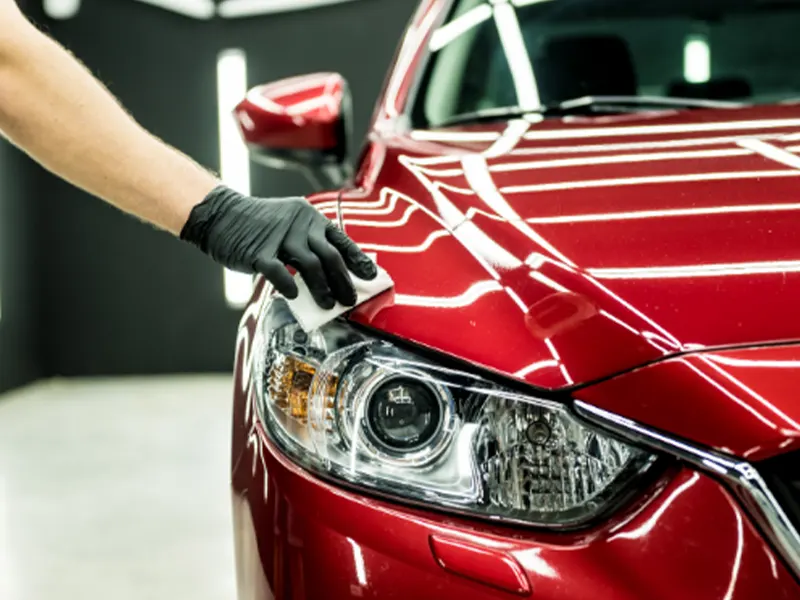Caring for a ceramic coated car requires some attention and effort, but it is worth it to maintain the vehicle’s appearance and protect its investment.
Ceramic coatings provide a long-lasting layer of protection, but they still require regular maintenance to keep them looking their best. Here are some tips for caring for a ceramic coated car:
1. Embrace Regular Washing with Precision
- Selecting the Right Soap: Always opt for a pH-neutral car wash soap without wax additives to preserve the integrity of the ceramic coating.
- Optimal Washing Conditions: Consider washing your vehicle during low light hours to prevent premature drying which can lead to water spots.
- Two-Bucket Method with Grit Guards: Utilize grit guards in two separate buckets – one for washing and another for rinsing – to prevent transferring dirt back onto the car, avoiding potential scratches.
2. Meticulous Drying Techniques
- Utilize Quality Microfiber Towels: Ensure they are clean and free from debris to prevent inadvertent scratches.
- Blotting Technique: Instead of wiping, consider blotting the water to minimize the risk of swirl marks.
3. Steer Clear of Automatic Car Washes
- Prioritize Hand Washing: Engage in a mindful hand wash to safeguard the ceramic coating from potential abrasions caused by automated brushes.
4. Employing a Clay Bar for Deep Cleaning
- Frequency: Use a clay bar sparingly and only when necessary to avoid undue wear on the coating.
- Lubrication is Key: Ensure the surface is well-lubricated while using a clay bar to prevent marring the surface.
5. Application of a Ceramic Coating Booster
- SiO2 Boost Spray: Consider using a SiO2 boost spray to rejuvenate the hydrophobic properties of the ceramic coating, ensuring water continues to bead off the surface effectively.
6. Opt for Compatible Wax and Sealants
- Check Compatibility: Ensure any additional products like waxes or sealants are compatible with ceramic coatings to prevent counteracting its properties.
- Enhanced Protection: A compatible sealant can add an additional layer of protection against contaminants and UV rays.
7. Avoiding Abrasive Products and Techniques
- Mindful Selection: Be cautious in selecting cleaning products and tools, ensuring they are gentle on the ceramic coating.
- Spot Testing: Always perform a spot test with any new product to ensure it doesn’t negatively impact the coating.
8. Annual Inspections and Touch-Ups
- Professional Check: Have a professional inspect the ceramic coating annually to assess its condition and perform any necessary touch-ups.
- Addressing Weak Spots: Ensure any areas showing signs of wear or diminished hydrophobicity are addressed promptly to maintain overall protection.
9. Mindful Driving and Parking
- Avoiding Contaminants: Be mindful of where you park your car, avoiding areas prone to bird droppings or tree sap, which can be particularly harsh on the coating.
- Safe Parking: Whenever possible, park in a garage or shaded area to minimize prolonged exposure to UV rays.
10. Addressing Stains Promptly
- Immediate Action: Any stains from bird droppings, bugs, or other contaminants should be cleaned off immediately to prevent them from etching into the coating.
- Gentle Cleaning: Use a gentle, pH-neutral cleaner for spot cleaning to ensure the coating is not compromised.
Incorporating these detailed tips into your ceramic coating care routine will not only enhance the longevity of the coating but also ensure that your vehicle continues to turn heads with its impeccable shine and flawless finish.
Always remember, the key to maintaining the aesthetic and protective qualities of a ceramic coating lies in regular and mindful maintenance.
What is a ceramic-coated car?
A ceramic coated car is a vehicle that has been treated with a ceramic coating, which is a liquid polymer that is applied to the car’s exterior surfaces to create a protective layer. Ceramic coatings are made of nanotechnology and contain SiO2 (silicon dioxide) or TiO2 (titanium dioxide) particles, which bond with the car’s paint and create a hard, durable, and glossy layer that helps to protect against scratches, UV rays, and other environmental factors.
Benefits Of Ceramic coatings
- Protection: The ceramic coating provides a layer of protection against environmental contaminants such as bird droppings, tree sap, and acid rain.
- Durability: The ceramic coating is extremely durable and can last for several years, protecting the car’s paint from fading and other damage.
- Glossy finish: The ceramic coating creates a glossy, reflective finish that enhances the car’s appearance.
- Easy to clean: The ceramic coating makes it easier to clean the car, as dirt and grime do not adhere to the surface as easily.
How to know if my car is ceramic coated?
If you are not sure if your car has a ceramic coating, there are a few ways to tell:
- Look for a glossy finish: Ceramic coatings create a very glossy and reflective finish on the car’s paint, which can be noticeably different from the finish on a car without a ceramic coating.
- Water beading: When a car has a ceramic coating, water will bead up and roll off the surface more easily than it would on a car without a coating. This is because the coating creates a hydrophobic effect, causing water to bead up and roll off the surface.
- Touch: A car with a ceramic coating may feel smoother and slicker to the touch than a car without a coating.

Which car types have a ceramic coating?
Ceramic coating is not specific to any particular type of car, as it can be applied to any vehicle with a painted exterior. It is available for all types of cars, including sedans, SUVs, sports cars, trucks, and even motorcycles. The ceramic coating is a popular option for car enthusiasts and those who want to keep their vehicles looking new and shiny for a longer period of time. It is also available as an aftermarket option for cars that do not come with ceramic coating from the factory. However, it is important to note that ceramic coating can be expensive and requires professional application, so it may not be a practical choice for everyone.
Maintenance Requirements
Ceramic coatings require less maintenance than traditional wax or sealant, as they are designed to be more durable and long-lasting. If your car has not required frequent waxing or other exterior maintenance for an extended period, it may have a ceramic coating.
Conclusion
By following these tips, you can keep your ceramic coated car looking its best for years to come. Remember to always use high-quality car care products and take the time to properly maintain your vehicle. With the right care, your ceramic coated car will provide long-lasting protection and a stunning finish.

John Smith, a Los Angeles-based car specialist and automotive writer, boasts over 20 years in the industry. With a background as a master technician and a decade-long writing stint at notable automotive publications, John now shares his expansive knowledge on CarFinite, simplifying car maintenance for readers.

